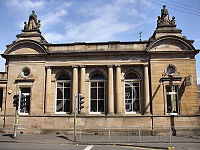
James Robert Rhind
Encyclopedia

Inverness
Inverness is a city in the Scottish Highlands. It is the administrative centre for the Highland council area, and is regarded as the capital of the Highlands of Scotland...
, Scotland
Scotland
Scotland is a country that is part of the United Kingdom. Occupying the northern third of the island of Great Britain, it shares a border with England to the south and is bounded by the North Sea to the east, the Atlantic Ocean to the north and west, and the North Channel and Irish Sea to the...
in 1854 and trained as an architect in his father's local practice.
He was successful in the architectural competition for new libraries to be constructed in Glasgow
Glasgow
Glasgow is the largest city in Scotland and third most populous in the United Kingdom. The city is situated on the River Clyde in the country's west central lowlands...
following Andrew Carnegie
Andrew Carnegie
Andrew Carnegie was a Scottish-American industrialist, businessman, and entrepreneur who led the enormous expansion of the American steel industry in the late 19th century...
’s gift of £100,000 to the city in 1901. His designs were selected for 7 libraries, allowing him to demonstrate his individual interpretation of Edwardian Baroque architecture
Edwardian Baroque architecture
The term Edwardian Baroque refers to the Neo-Baroque architectural style of many public buildings built in the British Empire during the Edwardian era ....
.
Rhind’s libraries were all built with locally quarried sandstone, which blended in with the existing tenement neighbourhoods. His landmark buildings were greatly enhanced by his liberal use of columns, domes and sculpted features. Many of the façades were decorated with stone and bronze statues by the noted Glasgow sculptor, William Kellock Brown.
Rhind retained his base in Inverness while he temporarily occupied offices in Glasgow city centre during the construction of the new Carnegie libraries.
Rhind's best known buildings in the north of Scotland are the Royal Golf Hotel, Dornoch
Dornoch
Dornoch is a town and seaside resort, and former Royal burgh in the Highlands of Scotland. It lies on the north shore of the Dornoch Firth, near to where it opens into the Moray Firth to the east...
and the Crown Church, Inverness.
External links
- James Robert Rhind (1854-1918) - contains a biography of James. R. Rhind
- Edwardian Baroque Architecture in Glasgow – James. R. Rhind
- Dictionary of Scottish Architects: J.R. Rhind

